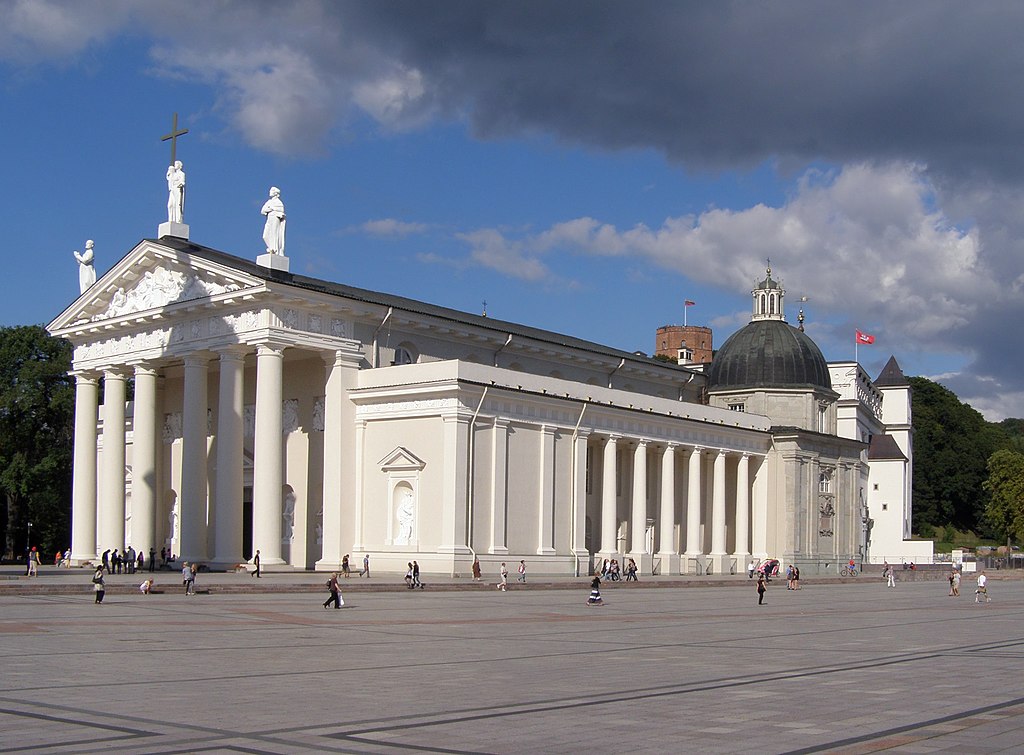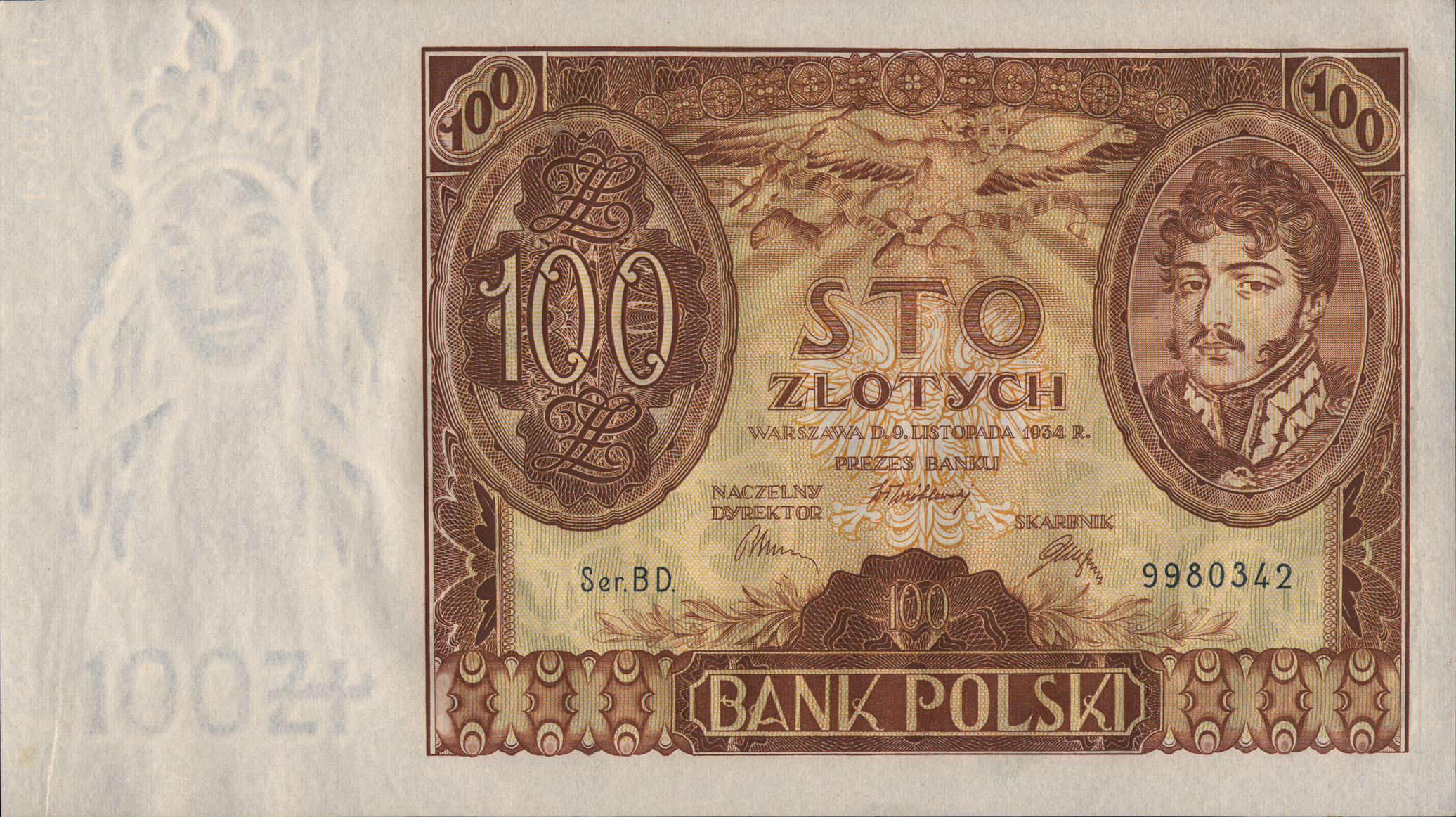The Polish-Lithuanian Commonwealth in the heart of the continent was one of the largest and most diverse European countries of the early modern age (16th-18th centuries), including the territories belonging nowadays to Poland, Lithuania, Latvia, Belarus and Ukraine, as well as scraps of Russia and Estonia. The Commonwealth was created as a result of the union of the Polish Kingdom and the Grand Duchy of Lithuania. Over a dozen ethnic groups lived in this area. The religious situation was even more complicated, as the early medieval division of Christianity into “eastern” and “western” running through the lands of the Commonwealth was increased by the rivalry of reform and counter reform currents and numerous migration processes.
by Melchior Jakubowski
In the modern Polish-Lithuanian Commonwealth, three rites of the Catholic Church coexisted: Latin, Greek and Armenian. The Latin Church had the strongest position, dominating the western part of the country and its noble elites. In the 16th century, although it was weakened by a wave of reformation, it soon regained its primacy. The Greek Catholic and Armenian Catholic Churches rose as a result of the union of some Eastern Christian clergy with the Roman Church. After the Brest Union (1596), Orthodoxy in the Commonwealth was divided between Greek Catholics and Orthodox followers who were hostile to each other. While the Greek Catholics retained their own liturgy, they acknowledged the primacy of the Pope and Catholic dogmas. In the 18th century, they constituted the vast majority of Ruthenians (ancestors of Ukrainians and Belarusians), but the Orthodox Church was still functioning, gradually becoming more and more connected with Russia. In 1630, the Polish Armenian Church concluded a similar union with Rome.
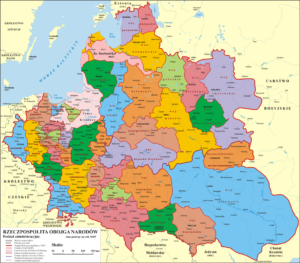
In the 16th century, various Protestant communities formed in the wave of the Reformation, of which Lutherans and Calvinists gained the greatest importance. Lutherans (Augsburg Evangelists) constituted the majority in the cities of Royal Prussia. Lutheranism was also a confession that ruled in the duchies of Prussia (later East Prussia) and Courland that were dependent on the Commonwealth. Calvinism, however, gained the most supporters among the nobility in Małopolska and the Grand Duchy of Lithuania, the majority of which, however, eventually returned to Catholicism.
The Commonwealth became famous as a “state without stakes” (using the term of the Polish historian Janusz Tazbir). In this extremely diverse country, there was almost no religious persecution, and the Polish-Lithuanian state became a place of refuge for many oppressed minorities from Western and Eastern Europe. Czech Hussites, Dutch Mennonites and Russian Old Believers enjoyed freedom of belief. Although tolerance primarily concerned the nobility, and over time it was limited (in 1658, the Arian community, a radical stream of reformation known in Europe as the “Polish Brethren”, was expelled), but the situation of religious minorities remained much better than in most European countries.
The most numerous among non-Christians were Jews, from the Middle Ages living in self-governing communes in Poland and Lithuania. Most of Judaism’s followers resided in cities, in many cases constituting the largest group of their inhabitants. In the 18th century, new trends in Judaism developed in the south-east of the Commonwealth, often perceived by Orthodox believers as heresies, including Messianic Frankism. Mystic Hasidism, born in the Polish-Lithuanian Commonwealth, later became one of the most interesting currents of 19th-century Judaism. Hasidism was fought by supporters of the Enlightenment Haskalah, i.e. the modern trend in Judaism, whose enthusiasts were interested in the ideas of Moses Mendelsohn, who was active in Berlin.
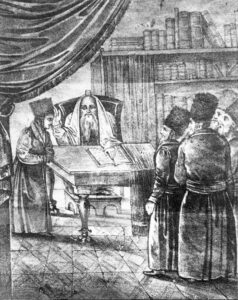
The smallest religious communities were formed by two groups of Turkish origin: the Tatars and Karaites. The Tatars were Muslims of the Sunni faction, and the Karaites professed their own religion, based on the Old Testament, but with the rejection of later Jewish tradition. Both lived in small municipalities scattered in the east of the Commonwealth. There were also small and disappearing pagan communities.
The eastern part of the country – the Grand Duchy of Lithuania and the Ruthenian lands of the Crown of the Kingdom of Poland – appears particularly interesting in terms of their multi-religious make up. It was there that one could meet representatives of almost all the religious groups mentioned above. Their close-knit relations are particularly evident in cities, where places of worship of various beliefs and religions have been preserved to this day. The location and appearance of sacred buildings and their mutual spatial relations can tell observers a great deal about old social relations and the specificity of individual towns.
The sheer number of cult objects is a testimony to the rank of the center, and are a reminder of its former splendor. An excellent example is Druja (Belarusian: Друя [Druja], English: Druya)[1], a small town on the current Belarusian-Latvian border, where remnants of at least four stone Baroque temples have survived to this day; two other buildings from the same period were destroyed in the first half of the 20th century, and it is known that several more existed.
In the urban layout of cities in the east of the Commonwealth, the privileged position of the Roman Catholic Church was clearly visible. It was first expressed in a large number of Latin temples, sometimes over-represented: Catholics usually had the biggest number of sacred buildings, regardless of whether they were the largest group of inhabitants.
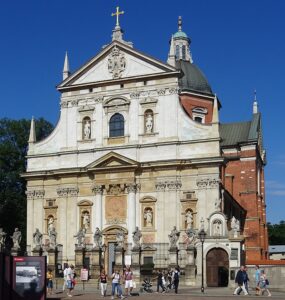
As a rule, the Latin Church also occupied the most prestigious location in the city, which was usually at the main square. It even happened in the Grand Duchy of Lithuania that two churches faced each other with the facade, side or rear wall at the market square. This was the case in Grodno (Belarusian: Гродна [Hrodna], English: Grodno) (St. Mary’s parochial church and St. Francis Xavier Jesuit church), in Połock (Belarusian: Полацк [Połack], English: Polotsk) (Jesuit and Dominican churches), in Słonim (Belarusian: Сло́нім [Slonim], English: Slonim) (churches of Franciscan sisters and Canons Regular of the Lateran) and in Głębokie (Belarusian: Глыбокае [Hlybokaje], English: Hlybokaye) (Carmelite and parish church, erected opposite each other, on both sides of the market). Churches in the frontages or corners of the markets existed in many cities. It was rare to find the Latin church and the Greek Catholic church (Halicz (Ukrainian: Галич [Hałycz], English: Halych), Minsk (Belarusian: Мінск [Minsk], English: Minsk) or Mir (Belarusian: Міp [Mir], English: Mir) or the Greek Catholic churches (Brzeżany (Ukrainian: Бережани [Bereżany], English: Berezhany), Raków (Belarusian: Ракаў [Rakau], English: Rakaw)) standing at the market square.
If there was a royal or noble residence in the city or in its vicinity, then only Roman Catholic places of worship operated in its area (let us mention, for example, the chapels in Brzeżany, Halicz, Nieśwież (Belarusian: Нясвіж [Niaswiż], English: Nesvizh) or Olesko (Ukrainian: Олесько [Ołeśko], English: Oles’ko)). In addition, regardless of whether the castle or palace had a chapel, the Latin church was usually the closest sacred building (the exception was Brody (Ukrainian: Броди [Brodi], English: Brody), where the Greek Catholic church of St. Jura was built closest to the fortress). In Podhorce (Ukrainian: Підгірці [Pidgirci], English: Pidhirtsi), the Greek Catholic church was closer to the residence than the Roman Catholic church, but the latter building was connected to the palace with a representative, scenic avenue. Looking at the map of Kamieniec Podolski [(Ukrainian: Кам’янець-Подільський [Kamjaneć-Podilśkyj], English: Kamianets-Podilskyi), one can notice the proximity of the castle and the Greek Catholic church in Karwasary (Ukrainian: Карвасари [Karwasari], English: Karvasaryi). However, this is a relative proximity: in fact, the two buildings are separated by a rock cliff, making access from the castle to the church more complicated and time-consuming than the road to the Old Town, where the Trinitarian Latin Church is next to the bridge leading to the castle. Wiśniowiec (Ukrainian: Вишнівець [Wiszniwiec], English: Vyshnivets) is an exception, where the palace was adjacent to the Greek Catholic church on the one side, and the Latin church on the other. In the Grand Duchy of Lithuania it happened that the Greek Catholic church in Grodno existed in the vicinity of the castle or palace.

The location of churches on hills was also a testimony to the rank of Roman Catholicism, often assuming a dominant place in the city’s landscape. Typical examples are the religious temples in Brzeżany, Podkamień (Ukrainian: Підкамінь [Pidkamiń], English: Pidkamin) or Krzemieniec (Ukrainian: Кременець [Kremeneć], English: Kremenets). It was much rarer for the Greek Catholic church (e.g. Husiatyn (Ukrainian: Гусятин [Gusiatyn], English: Husiatyn) or Pomorzany (Ukrainian: Поморяни [Pomoriany], English: Pomoryany)) to stand in the highest place of the town. Sometimes this issue is difficult to resolve unequivocally: in Halicz the highest standing was the Latin castle chapel, but it had serious competition in the form of a Greek Catholic church in nearby Kryłos (Ukrainian: Крилос [Krilos], English: Krylos). It was similar in Satanów (Ukrainian: Сатанів [Sataniv], English: Sataniv), where a Roman Catholic church was towering in the city, but in its immediate vicinity – a Greek Catholic Basilian monastery. A unique case is Podhajce (Ukrainian: Підгайці [Pidhajci], English: Pidhaitsi), where the synagogue was at the highest point in the town.
The prestigious location was usually followed by an impressive architecture: Roman Catholic temples were of considerable size, with varied features, rich decoration and equipment. Only where the city owners supported non-Catholics could they attempt to erect a more magnificent temple. This was the case in Kiejdany (Lithuanian: Kėdainiai, English: Kėdainiai) belonging to the powerful Radziwiłł family, where the massive body of the Calvinist church overwhelms the more modest Catholic churches.
The most tangible testimony to the former closeness (though not necessarily friendship) of people who differ in belief is the physical proximity of sacred buildings. Very often they were located on the same street. One can point to those standing on one street: the Latin church and the Greek Catholic church (e.g. Grodno, Kamieniec Podolski, Połock, Słonim, Trembowla (Ukrainian: Теребовля [Terebowlja], English: Terebovlia), Zbaraż (Ukrainian: Збараж [Zbaraż], English: Zbarazh), Złoczów (Ukrainian: Золочів [Zołocziw], English: Zolochiv)), the Greek Catholic church and the synagogue (Buczacz (Ukrainian: Бучач, English: Buchach) Grzymałów (Ukrainian: Гримайлiв, English: Hrymailiv), Słonim, Trembowla, the Latin church and the synagogue (Halicz, Nowogródek (Belarusian: Навагрудак [Nawahrudak], English: Novogrudok)) and the Armenian church and Greek Catholic church (Brzeżany).
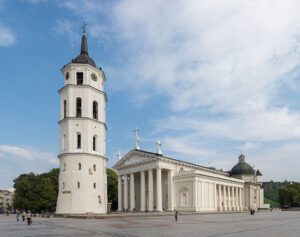
On the same side of the street were the Latin church and the Greek Catholic church in Zbaraż or Złoczów, the Latin church and the synagogue, and the Greek Catholic church and another synagogue in Trembowla. Opposite each other, on two sides of the street, the Dominican church and synagogue in Nowogródek, as well as the parish church and synagogue complex in Iwie could function, but their facades were not facing each other. A similar arrangement has survived to this day in Minsk, in which only the street separates the former Bernardine church and the rebuilt Basilian church. Symbolic significance can be attributed to the southern end of the old town of Wilno (lit. Vilnius, ang. Vilnius), where in front of the Latin Carmelite church, on one side there is the Orthodox Holy Spirit church, and on the other – a Greek Catholic Basilian church.
Most cities in the described areas developed dynamically and irregularly, without any arrangements, and the places of prayer of individual religious groups were mixed up. The exception to this rule was a group of cities founded in the modern period by their noble owners according to a specific plan. With these there is a tendency to place temples of worship of different beliefs and religions in different parts of the city. Brody, Stanisławów (Ukrainian: Івано-Франківськ [Iwano-Frankiwśk], English: Ivano-Frankivsk) and Tarnopol (Ukrainian: Тернопіль [Ternopil], English: Ternopil) in the Ruthenian lands of the Kingdom of Poland or Nieśwież in the Grand Duchy of Lithuania are among towns where sacred buildings were connected with each other by street axes.
A special case was Kamieniec Podolski, in which separate municipalities operated simultaneously: Polish (Latin), Ruthenian (Greek Catholic) and Armenian, which was reflected in the city’s topography. Roman Catholic churches were concentrated in its western part, near the so-called Polish Market, many Greek Catholic churches were in the north, near the Russian Market, and the Armenian churches were located in the south, next to the Armenian Market. However, this division was not strict and there were exceptions to it, such as the Greek Catholic church of St. John the Baptist, standing next to the Armenian Market.
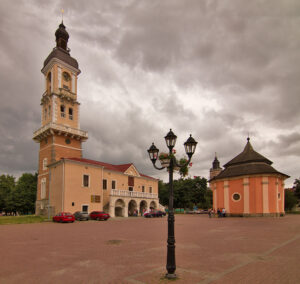
While Latin churches and Greek Catholic or Orthodox churches were located both in city centers and in the suburbs, the location of buildings belonging to smaller communities was subject to a characteristic rule. Armenian churches, synagogues and Karaite kenesas were almost always within the city limits, as long as the city walls existed; Tatar mosques were built in the suburbs. Such a relationship between synagogues and a mosque can be indicated, for example, in Iwie (Belarusian: Іўе [Iuje], English: Iwye) or Słonim. In turn, both Tatars and Karaites lived in Lithuanian Troki (Lithuanian: Trakai, English: Trakai). The Karaite kenesa rises there in the district closest to the two ducal castles, called the Karaim area, while the mosque stood further, on Lake Tataryszki (Lithuanian: Tatoriškės, English: Tatoriskes). Therefore, a significant difference can be seen between the Tatar settlement and other minorities.
Even taking into account the strictly organic development of towns in the east of the Polish-Lithuanian Commonwealth, one can speak of some spatial patterns in them. On their basis, one could even create an urban model of a typical multi-religious town in one of the eastern provinces. The most numerous group of people were Greek Catholics, praying in numerous, mostly wooden, churches. The Latin Church had a privileged position, and was usually proud of one but very impressive stone temple, situated on a hill or at the market, and also near the palace of the city owner. Somewhat out of the way, but still in the center, there were Jewish or Karaite prayer houses. If Armenians lived in the city, despite their small number, their economic and social position allowed the construction of a temple in the center. In turn, the wooden Tatar mosque could only be seen on the outskirts of the city. All the listed facilities were very close to each other. When going to Latin church, it was impossible not to pass the Greek Catholic church or synagogue. Physical closeness prevented a separation of people of different beliefs.

Collecting all the above examples was possible due to the author’s participation in trips to the former eastern lands of the Commonwealth[2]. Despite the losses suffered in two world wars and the deliberate destruction of sacred buildings in the Soviet Union, a significant part of temples and prayer houses built in the times of the former Polish-Lithuanian Commonwealth still exist. Although some of them no longer perform their original functions and some remain in ruins, they still remind us of the legacy of a multi-religious and multi-ethnic state. It is worth going to the small cities of today’s Belarus or Ukraine, forgotten by tourists, to discover the cultural richness of the heritage of many nations, as well as many beliefs and religions.
Author: Melchior Jakubowski
Translation: Alicja Rose & Jessica Sirotin
[1] Henceforth the names of localities are mentioned in the text in the form in which they were used in the Polish-Lithuanian Commonwealth. The contemporary name in the language of the country in which the place is located is given in parentheses [in the case of Cyrillic languages – with Latin transliteration in brackets] and in English, when mentioned for the first time.
[2] Zob. Miasta wielu religii. Topografia sakralna ziem wschodnich dawnej Rzeczypospolitej, red. M. Jakubowski, M. Sas, F. Walczyna, Warszawa 2016.

